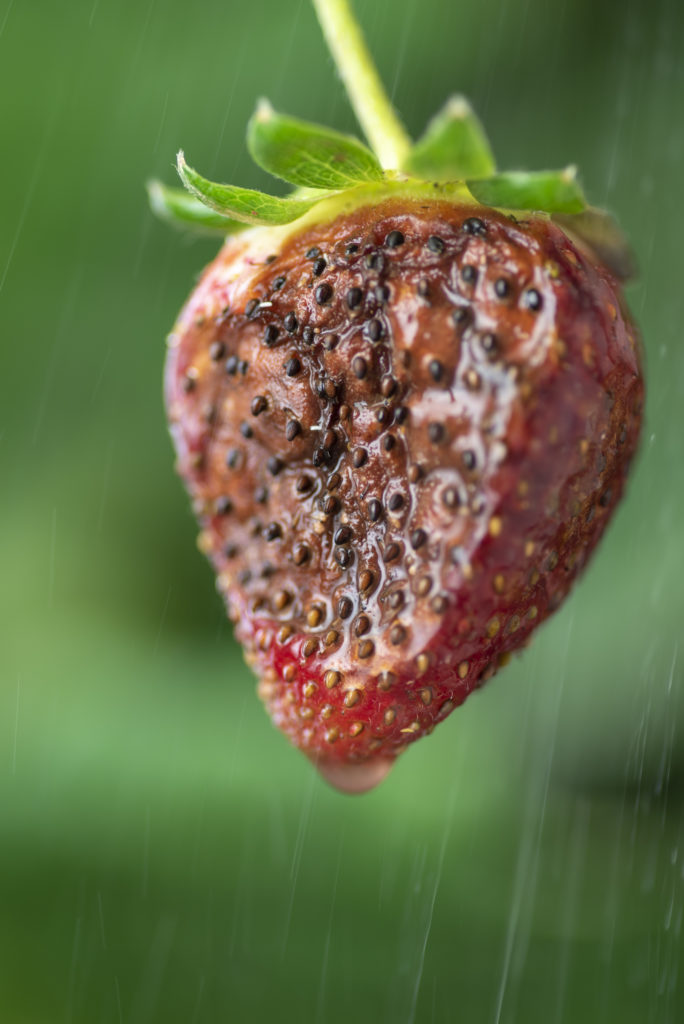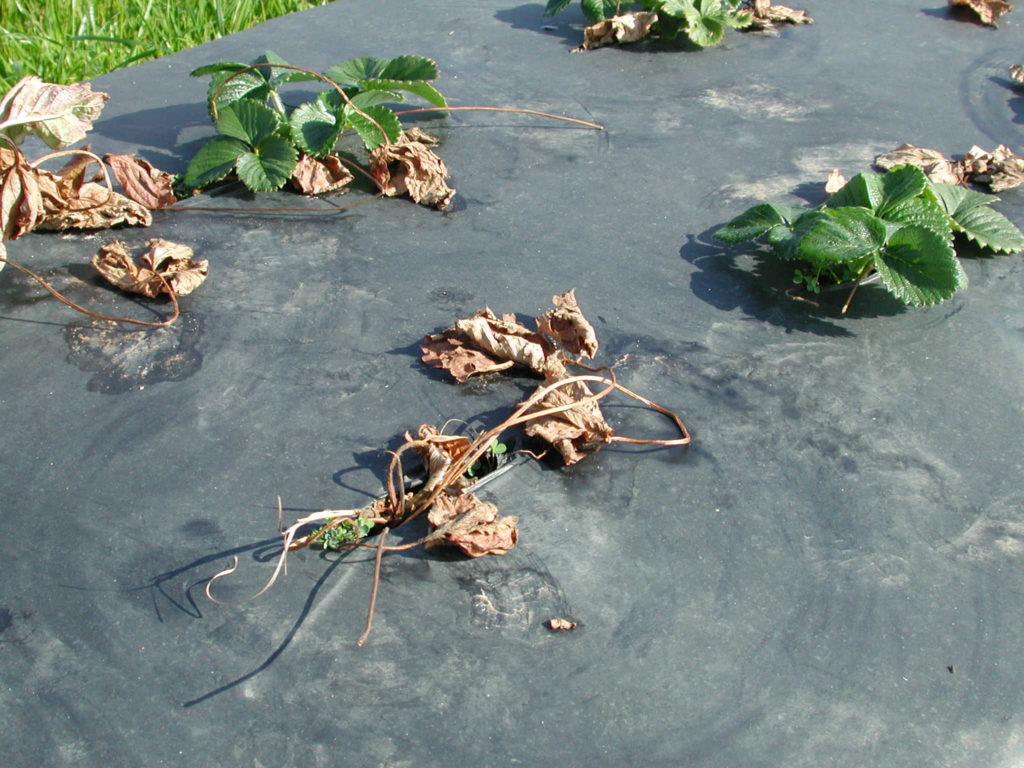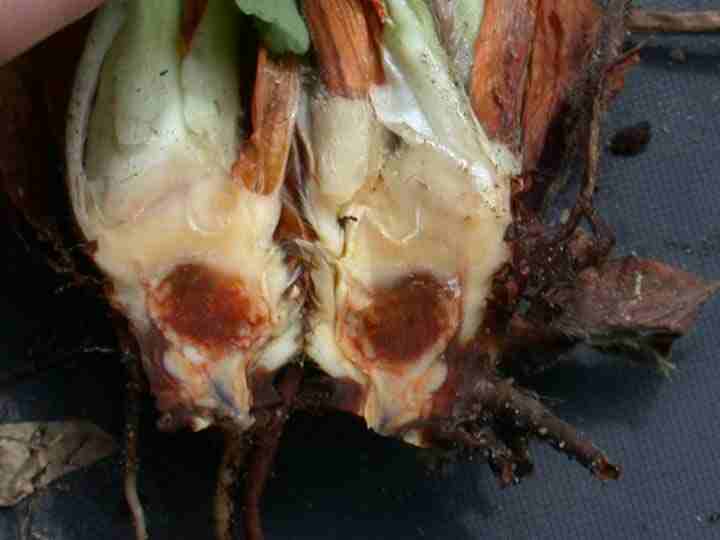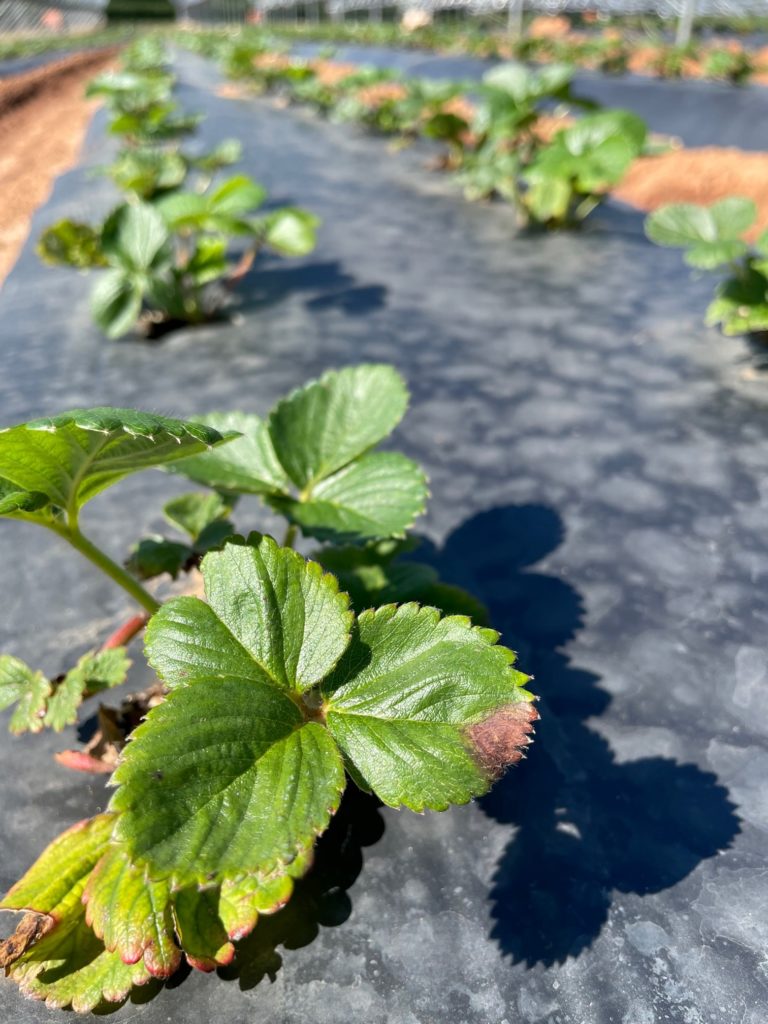By Jeff Cook, Garrett Hibbs and Phillip Brannen
The key to a successful strawberry season is protecting the plants and developing fruit from insects and diseases. Other than spider mites, fungal diseases pose the biggest threat in the form of production losses. Using multiple disease control strategies helps reduce damage and is important in disease resistance management.

(Photo courtesy of Madeline Dowling, Clemson University)
FIRST STEPS AND FUNGICIDES
As with any crop disease, management begins at planting. Be sure to inspect plugs or bare root planting materials when they arrive at the farm.
Both phytophthora crown rot and anthracnose crown rot (ACR) can be brought in on contaminated planting material. Discard obviously diseased transplants and monitor plantings for petiole lesions, stunting and plant death.

(Photo courtesy of Guido Schnabel, Clemson University)
Several fungicides are effective at managing ACR. Due to label restrictions and resistance management, we recommend avoiding strobilurin fungicides in Fungicide Resistance Action Committee (FRAC) group 11 early in the season. A better use of these products is for anthracnose fruit rot later in the growing season. Captan products are good for use in the fall, if needed for leaf spots, and early spring. These products have good activity against anthracnose and botrytis.
In the past, if phytophthora crown rot was detected in a planting, the most effective fungicide active ingredient was mefenoxam. However, fungicidal resistance has started to develop in some locations for this fungicide.

(Photo courtesy of Guido Schnabel, Clemson University)
A new product, Orondis Gold, contains both mefenoxam and oxathiapiprolin fungicides in one product, so it is now a preferred product for use in the fall and early spring. However, Orondis Gold has a 28-day pre-harvest interval, so mefenoxam products are still the only game in town for spring use. These products show excellent efficacy when applied through drip irrigation. Applications can be made shortly after planting and again in the spring. Applications should be timed to coincide with periods of rapid root growth.
Although it is not a common practice in Georgia, pre-plant fungicide dips can be effective at suppressing certain soilborne pathogens and diseases that may be present on transplant material. Abound and Switch can be used if plants are known to be infected with anthracnose. Phosphites can also be used to help manage pythium and phytophthora problems.
After planting, and prior to flowering and fruit set, fungicide applications are rarely needed. Occasionally, rainy fall weather results in excessive leaf spot, scorch or blight. If control measures are needed, it is recommended that growers use fungicides that have reduced risk for developing resistance. Leaf spot diseases are easy to control with products like Captan or Rally.
TREATING TWO FOES
Once flowering begins and fruit set occurs, the goal shifts to protecting fruit from two major diseases: anthracnose fruit rot (AFR) and botrytis (also known as gray mold). Both diseases can cause considerable yield losses if left unchecked.
Fungicide programs in the Southeast should be focused on suppression of diseases using good broad-spectrum fungicides with low risk for resistance development. Products like Captan and Thiram are good for suppression of both AFR and botrytis.
As fruit ripens and growers begin to harvest ripe berries, it is often necessary to switch to more effective fungicides for these diseases. In addition, some of the contact fungicides can leave unsightly residues on fruit.
For some time, Switch has been very useful in managing botrytis fruit rot. Today there are several new fungicides that also provide acceptable control and are useful tools in managing disease resistance. It is still recommended to avoid strobilurin fungicides (FRAC 11) if botrytis is the only disease identified.
Botrytis has developed resistance to numerous classes of fungicides, so we recommend that botrytis be tested each year to determine which fungicide classes are active. Clemson University offers this service for free. Check with your local county Extension agent for assistance with the process. This service can help you determine which fungicides should be the most effective and which fungicides to avoid.
The strobilurin fungicides are generally the most effective class for controlling AFR if resistance has not developed in your location. If resistance has developed, then other products like Switch can be utilized as well. This disease is not always a problem. However, severe outbreaks have occurred. AFR typically becomes more active as temperatures begin increasing later in the season. There are efforts from southeastern breeding programs to release cultivars with resistance to this disease.
To help slow disease resistance on your farm, use multiple modes of action and FRAC groups in your disease management arsenal. Limit the number of times fungicides of the same group are applied in a single year and avoid back-to-back use of fungicides in the same group.
An example for controlling AFR would be Merivon (7,11) followed by Captan (M4), followed by another FRAC 11 fungicide if needed. For botrytis, follow the fungicide of choice with Captan or another broad-spectrum fungicide. If disease conditions are conducive, such as wet and with active disease in the field, you may need to tank-mix Captan and other broad-spectrum fungicides for additional control.

(Photo courtesy of Guido Schnabel, Clemson University)
NEW PROBLEM: NEOPESTALOTIOPSIS
Finally, a new disease, Neopestalotiopsis fruit rot, was reported to cause damage in strawberry fields in Florida in 2019. Since then, it has been detected in several states. This disease causes leaf spots, fruit rot and crown damage.
Diagnosis in the field is difficult because it looks like several other common diseases. It is important to have Extension personnel or crop consultants positively identify this disease to help develop control strategies.
Currently, Thiram is the only fungicide that can be widely used to slow the spread of Neopestalotiopsis. Certain states have received special labels for control of this disease. It is always recommended that you check with appropriate authorities to determine which products are labeled in your state. Read and follow all label instructions and restrictions.
GROWER TOOLS
With any pest management plan, proper identification of the pest is critical. A useful tool, the MyIPM app, was developed several years ago by Extension specialists from across the Southeast to help fruit growers control and manage diseases and pests in crops. Learn more about the MyIPM app at myipm.app or download it for free from your app store.
For production and integrated pest management guides, visit the Southeastern Small Fruit Consortium (smallfruits.org).
Jeff Cook and Garrett Hibbs are county Extension coordinators for University of Georgia (UGA) Cooperative Extension. Phillip Brannen is a UGA Extension fruit disease specialist.









